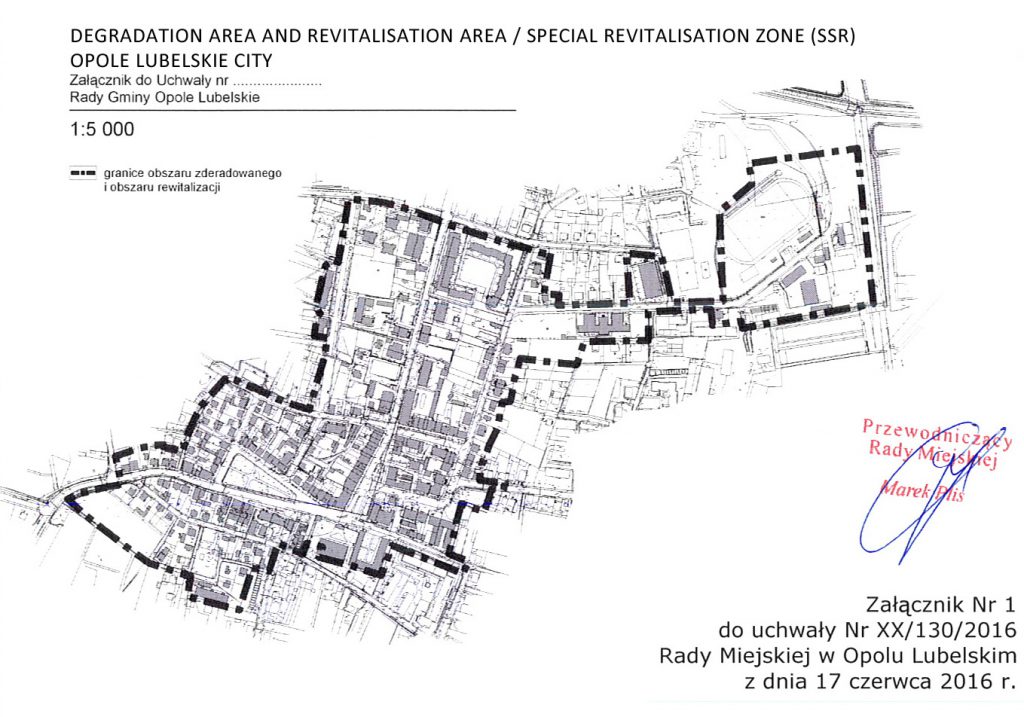OPOLE LUBELSKIE


Period of revitalisation activities
Revitalisation activities in the Opole Lubelskie Commune have been carried out since 2007. The first document setting out the directions for revitalisation for the period 2007-2013 was the “Local Revitalisation Programme for Opole Lubelskie”. The programme was developed in cooperation with the inhabitants of the city and the institutions and organisations operating in its area. The programme has been functioned in the local community for 3 years. The Local Revitalisation Programme for Opole Lubelskie was updated in 2009. The document was prepared for the period 2009-2014. While analysing the revitalisation process, the commune took two main directions of development. Firstly, it was the implementation of projects consisting in the adaptation and renovation of all municipal buildings or other entities, could be used for social purposes, such that will generate activities aimed at professional activation of the unemployed, increase educational and cultural initiatives, social activities, pro-social activities and promotion of entrepreneurship. At the same time, revitalisation of historic buildings was carried out, including sacral buildings – the Post-Jesuit Monastery. Among other things, the “Opole Sugar Factory” were renovated. Subsequently, since 2014 the Municipality started work on the development of the Municipal Revitalisation Programme for 2014-2024, which now has a comprehensive character and responds to the problems of the inhabitants of the revitalisation area.
Characteristics of the revitalisation area problems
• Social sphere
The revitalisation area is characterised by depopulation and aging society. Another negative phenomenon is unemployment. Within the degraded area, the share of the unemployed in 2015 amounted to 12.07% and was almost twice as high as the indicator for the city. Most of the unemployed want to work legally, under an employment contract, full-time and on a permanent basis. The barrier is education inadequate to the current labour market or its lack. Within the designated revitalisation area, a high level of dependence on social assistance was also noted. Another serious social problem is domestic violence, including violence against the elderly, in relation to whom it often takes less obvious forms, such as emotional rejection or isolation from the rest of the family.
The area is marked by high crime rates. According to the revitalisation team members, acts of vandalism are also a big problem. Attention was also paid to the concentration of people who abuse alcohol in this area.
• Spatial and functional sphere
Spatial and functional problems include in particular: insufficient technical and social infrastructure or its poor technical condition, lack of access to basic services or their poor quality, no urban solutions to the changing functions of the area, low level of public transport, shortage or low-quality public spaces.
The examination of tall greenery located in the area proved its very bad condition. Over 100 trees require replacing. The main reason for the poor condition of greenery is the location close to main traffic routes, lack of adequate access to water, age and inadequate tree species for urban conditions.
Within the revitalisation area, i.e. within the strict city centre, the lack or poor technical condition of the water supply and sewage systems was found.
The area is thus an important element of cultural heritage, 66% of its surface is protected in the register of monuments (historic urban layout). However, a maladjustment of urban solutions to the changing functions of the area, the shortage or low quality of public spaces, especially in the historical squares and main pedestrian routes in the city centre, were observed.
• Technical sphere
The conducted analyses have confirmed the existence of local coal-fired boiler houses and individual furnaces (usually of low efficiency) in Opole Lubelskie, working on poor quality coal or even waste generated by households. This form of heating is most often found in pre-war buildings, devoid of technical solutions enabling efficient use of the buildings, in particular in terms of energy efficiency. Most of such buildings are located in the city center. In the revitalisation area, there are a number of streets where the poor condition of the existing buildings and public spaces has been diagnosed.
• Environmental sphere
In the revitalisation area, dust and gas pollutions higher than in the surrounding rural areas are noticed. Low emitters in compact, build-up quarters are particularly troublesome. The main source of pollution is, however, transport, especially transit one, on voivodeship roads, which is particularly burdensome for people living in the buildings located along these roads and therefore within the range of the influence of toxic components of exhaust gases.
In Opole Lubelskie, low emissions from local coal-fired boiler houses and individual home furnaces as well as traffic emissions have the main impact on air quality. In the area pollution is mainly caused by a provincial road with heavy traffic passing through the city centre, the lack of systematic control of the fuels as well as of a system for replacing old stoves.
• Economic sphere
Research on the condition of local entrepreneurship has shown that the strengths of local companies depend on an easy access to them for customers and potential customers, as well as on the knowledge and attractiveness of the offer.
Description of the revitalisation area development character
The area covered by the analysis is marked by a diversified land development structure. Single-family and multi-family housing dominate, occupying almost 41% of the area. The single-family housing is located along the following streets: Długa, Projektowana, Cicha, Stary Rynek, Ogrodowa and Partyzantów. The multi-family housing is located at Lubelska Street, Morwowej Street (previously 25-lecia PRL), and Projektowana Street (building inhabited by the Roma community).
In the centre of the revitalisation area (Stary Rynek, Nowy Rynek) and along the main streets: Lubelska and Kościuszki, there are public buildings and numerous commercial and service facilities. The ownership structure of the area is dominated by the public land, which constitutes nearly 60% of the total area.
Within the strict city centre, the lack or poor technical condition of the water supply and sewage systems was found.
Main revitalisation activities
- Tenement Renovation Programme
The main objective of the programme is to create mechanisms and conditions for revitalisation of the tenement houses in order to regain or increase their functional, technical, economic, and cultural value. The programme includes, in particular, the architectural and construction concept for the renovation of the tenement houses located in Opole Lubelskie and the preparation of conceptual solutions for the building façades, humidity insulation, thermal modernisation, replacement of windows, doors and roofs, replacement of balustrades as well as of signs and advertising boards, new lighting, including store windows, adaptation of entrances to the needs of people with a disabilities, numbering of the buildings.
The programme executor will also be responsible for preparing architectural concepts for the renovation of individual tenement houses with regard to their further individual owners.
The Programme for the Renovation of the Historical Town Centre of Opole Lubelskie was developed as part of the project “Opole Lubelskie – to touch, to taste – preparation of the Opole Lubelskie municipality to the economic and social revitalisation of the degraded areas” co-financed by the European Union, European Cohesion Fund under the Operational Programme Technical Assistance 2014-2020.
Establishment & tools for Special Revitalisation Zone
- Date of establishing the SSR: 2018
- Area of the SSR: revitalisation area designated by the Resolution No. XX / 130/2016 of the City Council in Opole Lubelskie of June 17, 2016
http://opolelubelskie.pl/sites/default/files/uchwala_w_sprawie_wyznaczenia_obszaru_rewitalizacji_i_zdegradanego.pdf - Tools indicated in the SSR: subsidies for construction works consisting in renovation or reconstruction, and for conservation and restoration works in buildings not entered in the register of monuments for owners or perpetual users of real estate located in the SSR
- Level of co-financing in the SSR: depends on the scope of work/individual city programme:
– 15% – protecting and preserving the building substance;
– 30% – renovation or supplementation of plaster and architectural cladding or their complete reconstruction, taking into account the colour characteristic for the monument;
– 40% – renovation or complete reconstruction of windows, including frames and window frames, external door frames and doors, roof truss, roofing, gutters and downspouts;
– 15% – anti-moisture insulation;
– additional 10 pp to the elevated thresholds, works concern more than one of the listed elements, the increase applies to each work element by additionally 10 pp.;
– housing community is the subsidy beneficent; the scope of works covered by the application concerns at least two additional 10 p.p. elements;
– simultaneous implementation of the Programme for restoring vacant flats in tenement houses for rent (only for the flat owners, housing communities are excluded from the bonus). - Necessary financing works: securing, preserving and consolidating the substance of the monument; restoring or supplementing plaster and architectural cladding or their complete restoration, taking into account colours characteristic for this monument; restoring or complete restoration of windows, including frames and shutters, external doors and doors, roof trusses, roofing, gutters and downpipes; execution of damp insulation.
- Procedure of announcing the call for grant applications in SRZ: 30 days before the date of the call; publication in the local press, on the website and on the office notice boards.
- Deadline for submitting grant applications concerning location in SRZ: 15 September of the year preceding the works.
- Composition of the evaluation committee: established by order; composition: employees of the town hall.
- Rules for the determination of calls for grant applications in the SRZ: The call is resolved after the established budget for the adopted year. There is no provision for an additional call in case the grant is not used.
- Number of announced calls for applications: none
- Number of subsidies awarded in respective calls: none
- Link to the resolution on the SSR: https://umopolelubelskie.bip.lubelskie.pl/upload/pliki/rm493582018.pdf
- Link to the publication promoting the SSR prepared by the city:
http://www.opolelubelskie.pl/aktualnosc/specjalna-strefa-rewitalizacji-uchwalona
